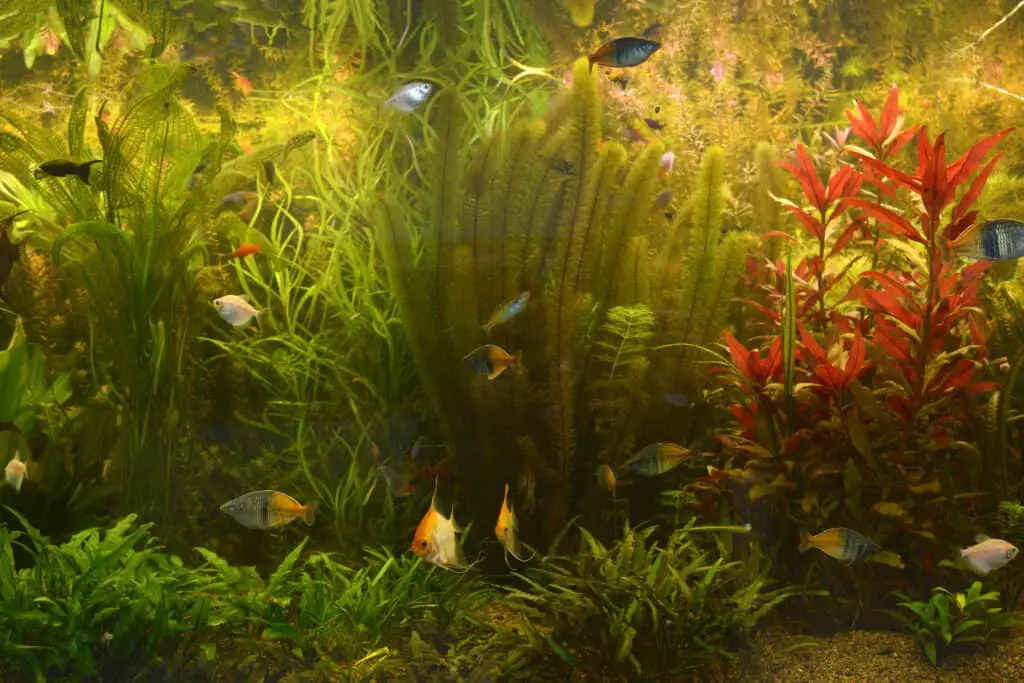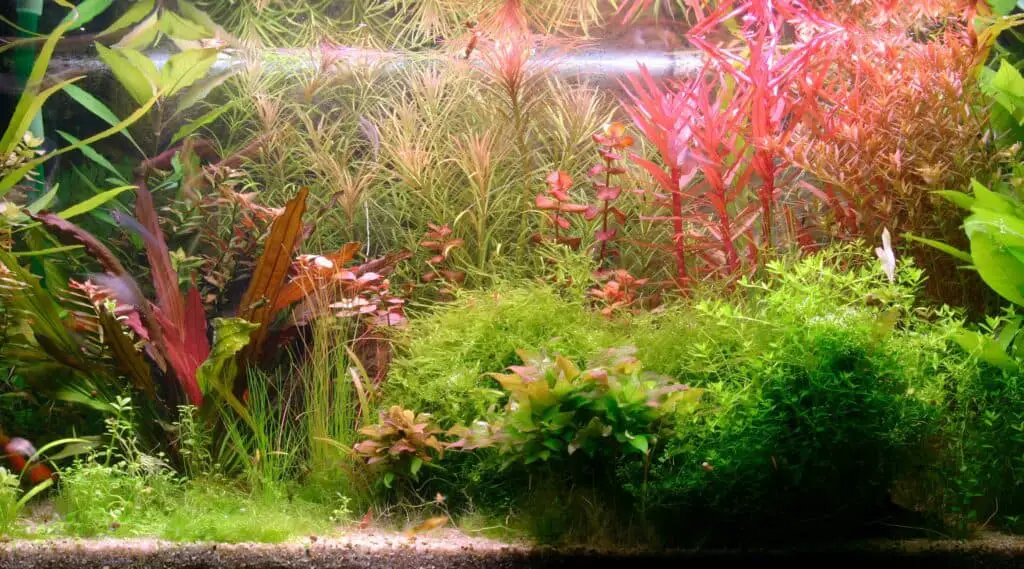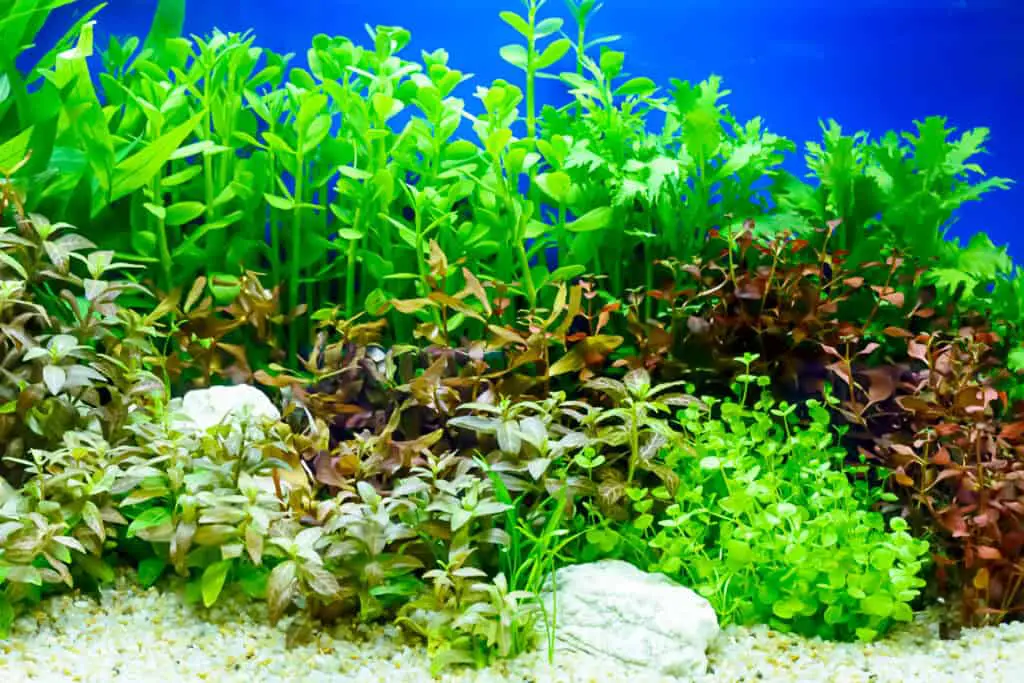
Fish hobbyists know that live plants play a vital role in making an aquarium ecosystem balanced and visually appealing.
Knowing though if the plants are simply surviving in a tank, or thriving can be somewhat difficult.
Plants that have visibly vibrant colors, are steadily and robustly growing, have a strong root system, and in some cases depending on the plant species, are growing offshoots for new plants, which are all signs of a thriving aquatic plant.
Let’s dive deeper into factors that help contribute to thriving aquatic plants, along with some aspects that may lead to common problems and how to maintain and care for your aquatic plants, to help ensure a lush and thriving planted aquarium environment.
Understanding the Basics of Aquarium Plant Health
There are three basic needs of any aquarium plant, these are light, nutrients in correct proportions, and correct water parameters.
As with plants outside of water, aquatic plants require light to begin the photosynthesis process, which in turn enables the plants to grow.
Nutrients are the food that the aquarium uses in growth, these include macro and micronutrients that are required in the right amounts for a foundation set for thriving plants.
The three foundational macronutrients that all plants require are Potassium, Phosphorus, and Nitrogen.
These should also be the main ingredients in any fertilizer one might use.
Water parameters are more species-specific for each type of plant, but in general keeping parameters constant will allow your plants to become accustomed and flourish.
The inability of plants to acquire these three basic needs will often lead to poor health and stunted growth.
That’s why it is important to understand what is required for their basic health and to ensure your tanks are meeting their needs to lay out an environment where your plants have the best chance to thrive.
Having a good environment is the first step in knowing if your plants are thriving, as it gives them the best chance to do so.

Signs of Healthy Aquarium Plants
Active Growth
One of the biggest signs of healthy aquarium plants is active growth.
Having new plants, new offshoots, and growing taller or wider are all excellent signs that your plants are thriving.
In most cases when the environment is optimal that’s what your plants will do, as this means typically the nutrients and water parameters are all in balance allowing for the photosynthesis process to continue.
To learn more about your plants beginning to grow and becoming established in your tank, read my article here.
Root System Growth
A strong root system though not going to be seen in most cases, goes along with the constant growth of the plants.
As the plant grows above the substrate, so does it below to keep up with nutrients, replacing older parts of the plants with new, ones and providing a bigger anchor point to sustain and support the growth above.

Vibrant Coloration and Lack of Damage
Thriving and healthy plants will also have vibrant colors and be limited in signs of physical damage.
Though older leaves may wither over time, new growth should be actively seen.
This new growth along with healthy existing parts of the plant will be in good coloration.
Based on the plant these colors will differ, but in most cases, if there is a problem, leaves and parts of the plant will begin to turn yellowish brown as they begin to die back or melt. If you would like to know more about plant melt, read my article here.
Plants may also show signs of an issue with holes beginning to form in their leaves.
If your plants lack holes or other signs of damage, there is a very good chance that your plants are thriving and doing well in your tank.

The Role of Lighting and Fertilization
It is important to lay the foundation correctly for your plants, by making sure the environment you create in your aquarium is set up to allow your plants the best chance to thrive.
Laying this foundation includes two of the most important resources your plants need, which are light and nutrients.
Having these two resources available and balanced, will create an environment where your plants are set up to succeed, and gives a good idea that your plants are thriving.
Lighting for Your Plants
Light is the engine for plant growth, and without it will not allow plants to thrive. In general, anywhere between 10 and 12 hours would be considered ideal for most aquarium plants.
It will also play a role if you decide to add supplemental CO2 to your tank, as plants are only able to utilize the additional CO2 while they have access to light.
If CO2 is being added while the lights are off, it is only being wasted, eventually getting dissipated from the water with no benefit being given to the plants.
Fertilizing Your Plants to Provide Balanced Nutrients
Fertilizer provides the ability to add and or balance the nutrients in your tank that will become depleted over time from plants using them.
The two general forms of fertilizer are liquid which is added on a weekly or bi-weekly schedule and varies the amount based on tank size, and the amount of plants.
The other form is root tabs which are placed in the substrate and provide nutrients to the surrounding plants.
These are normally replaced every couple of months as they become used by the plants.
If you would like to learn about how often you should be fertilizing your plants, be sure to check out my article here.
Final Thoughts
Having aquarium plants in your tank is sometimes seen as a mystery on whether they are doing well or not.
But understanding how to set up an environment for them to thrive, and looking for details that plants are giving to tell you if they are thriving or not is key.
Be sure to research your specific plants for any special requirements they may have.
